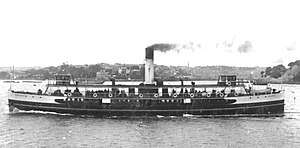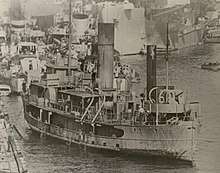HMAS Burra Bra
Burra Bra was a Manly ferry on Sydney Harbour that operated by the Port Jackson & Manly Steamship Company from 1908 until 1940, before being requisitioned by the Royal Australian Navy for use as an anti-submarine training vessel and target tow during World War II.
 Burra Bra as built, ca. 1909 | |
| History | |
|---|---|
| Name: | Burra Bra |
| Operator: | Port Jackson & Manly Steamship Company |
| Port of registry: | Sydney |
| Route: | Manly |
| Builder: | Mort's Dock |
| Yard number: | 33 |
| Launched: | 17 June 1908 |
| Out of service: | 1940 |
| Name: | Burra Bra |
| Commissioned: | 1 February 1943 |
| Fate: | Sold in 1947 and scrapped |
| General characteristics | |
| Tonnage: | 458 gross tonnage |
| Length: | 195 ft (59 m)[1] |
| Beam: | 31.6 ft (10 m)[1] |
| Depth: | 14.3 ft (4 m)[1] |
| Decks: | 2 |
| Armament: |
|
"Burra-Bra" is an Australian Aboriginal name for The Spit in northern Sydney.[2]
Ferry service
.jpg)
Burra Bra was built by Mort Docks and Engineering Co, Woolwich for the Port Jackson & Manly Steamship Company for the Manly service. Launched on 17 June 1908, it was the second of six Binngarra type Manly ferries. Almost identical sister ship to Binngarra (1905), Bellubera (1910), Balgowlah (1912), Barrenjoey (1913 - later North Head, and Baragoola. She made her trial run on 6 November 1908.[2]
At 59 metres in length and with a gross tonnage of 458 tons, she had a passenger capacity of 1,448.[2] With her open upper deck, her winter capacity was 916 passengers. Her triple-expansion steam engines generated 100 hp and powered her to a maximum of 13 knots.[3]
During the 1928 Roman Catholic Congress, the church used the vessel to ferry delegates to Manly. She was painted white with a large cross on either side of her funnel and was escorted many smaller craft and other ferries.[4] She was the flag ship for the Pittwater Regatta on 28 December 1929.[2]
She became the last of the open upper deck Manly ferries; unlike her sisters, Bellubera, Barrenjoey (North Head), and Baragoola her upper decks were never enclosed. The second oldest of the Binngarra type ferry (Binngarra of 1905 was hulked in 1933), she was used as a spare ferry from the mid-1930s.[5] The ferry was withdrawn from service in 1940.[1][6]
Naval service

On 13 November 1942 during World War 2, it was requisitioned by the Royal Australian Navy. Her superstructure was stripped down, one wheelhouse removed, and she was fitted out by Poole and Steel Limited (Sydney) and armed with one 12-pounder on the stern, two Vickers machine guns, and two depth charge chutes. She was commissioned HMAS Burra Bra, with the Pennant Number 69, on 1 February 1943. Based at Jervis Bay, the navy used her at sea as an anti-submarine training ship and as a target towing vessel for aircraft torpedo and bombing practise.[5] On 25 August 1943 Burra Bra was purchased by the Commonwealth government. It was laid up on 1 June 1944 at Athol Bight adjacent Bradley's Head, before being used to supply steam to vessels under refit. It was sold in November 1947 for stripping and later scuttled at sea.[5][6][7][8]
Chronology
 Painted white for the 1928 Roman Catholic Congress to carry delegates to Manly.
Painted white for the 1928 Roman Catholic Congress to carry delegates to Manly. With a capacity spectator crowd, 1920s or early 1930s
With a capacity spectator crowd, 1920s or early 1930s At Bennelong Point as an RAN anti-sumbarine vessel
At Bennelong Point as an RAN anti-sumbarine vessel
See also
References
- Launching of the Burra Bra Sydney Morning Herald 18 June 1908 page 3
- Andrews, Graeme (1975). The Ferries of Sydney. A.H. & A.W. Reed Pty Ltd. p. 45. ISBN 0589071726.
- Prescott, AM (1984). Sydney Ferry Fleet. Magill South Australia: Ronald H Parsons. p. 61. ISBN 0909418306.
- Andrews, Graeme (1975). The Ferries of Sydney. A.H. & A.W. Reed Pty Ltd. pp. 45 & 56. ISBN 0589071726.
- Andrews, Graeme (1982). A Pictorial History of Ferries: Sydney and Surrounding Waterways. Sydney: AH & AW Reed Pty Ltd. p. 64. ISBN 0589503863.
- SS Burra Bra Ferries of Sydney
- Burra Bra Ferry & Warship Naval Historical Society of Australia
- navy.gov.au
External links
